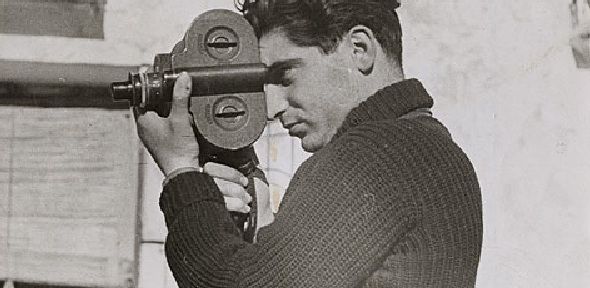This paper is available for the academic year 2023-24.
The paper offers a comparativist exploration of Iberian and Latin American cinemas, from the so-called silent period to the present day. Organized in terms of key topics, it examines important filmmaking traditions, movements and debates that have emerged in the Ibero-American context and helped to shape it. This organization provides students with a critical and theoretical knowledge of reading different film making forms, such as avant-garde films, indigenous texts, popular cinema and transnational filmmaking, while also allowing them the tremendous possibility for transcending traditional local, national and linguistic divisions in order to pose broader comparative questions. In doing so the paper’s structure reconfigures the traditional metropole-colony dichotomy into a more nuanced and multipolar interpretive frame. At the same time, individual lectures will situate films in their social, political, historical and cultural context, thereby highlighting the specificity, locatedness and historicity of cinematic production and reception, including in certain instances their relationship to state institutions. The course will thus provide students with ways of critically understanding the connectivities and dissimilarities of the cinematic culture of the Ibero-American world. Films will be viewed in their original versions with English subtitles.
The following are examples of what has been taught in the past.
Topic One: Early Film Technologies in the Ibero American World
Lectures within this topic explore some of the main issues and debates that surround the study of the arrival and development of new film technologies in the Ibero American context, from the introduction of pre-cinematic modes such as magic lanterns and panoramas and the cinematic medium in the late 1800s, to the elaboration of early silent melodramas and the development of synchronized sound movies. Lectures have looked at the impact of the arrival of the cinema and of cinematic technology in Spain, Brazil and Colombia, looking at their intersections with modern urban society, the rise of sound and the early development of silent genres.
Examples of Films:
El heredero de casa Pruna/ L'hereu de Ca'n Pruna (dir. Segundo de Chomón, 1904)
Le scarabée d'or (dir. Segundo de Chomón, 1907)
El hotel eléctrico (dir. Segundo de Chomón, 1908)
Une excursion incohérente (dir. Segundo de Chomón, 1909)
La operación del Dr. Posadas (Argentina, 1899): https://www.youtube.com/watch?v=TPtVFJdmdWU
La mosca y sus peligros (Argentina, 1920): https://www.youtube.com/watch?v=O7N1MF0kp4s
Instituto Butantan (Brazil, 1926): https://www.youtube.com/watch?v=h7FpEg5NXWQ
Entre los hielos de las Islas Orcadas (Argentina, 1928): https://www.youtube.com/watch?v=w6nl7NJL_Lk
Or
https://www.youtube.com/watch?v=rXa519_OfiI (in this second file from the Di Film archive there are some scenes that aren’t included in the other version)
São Paulo, a Sinfonia da Metrópole (Brazil, 1929): https://www.youtube.com/watch?v=zgKIXzuRDYM
Topic 2: Popular Film Traditions and Genres
This topic focuses on various forms of popular cinema produced in the Ibero American world, exploring films genres, from 1950s Mexican melodramas, horror and gothic films in Spanish cinema looking at their relationship with Francoist politics, and contemporary film noirs in Colombia and Argentina focusing on how their reimagine uncontrollable urban growth occasioned by the country’s ongoing political conflicts and the collapse of public space resulting from the drug wars of the 1990s.
Example of Films:
Carnaval Atlântida (dir. Carlos Manga, 1952)
Matar ou Correr (dir. Carlos Manga, 1953)
Nem sansão, nem dalila (dir.Calos Manga, 1954)
César Amadori, Luis. Dios se lo pague (Argentina, 1948) https://youtu.be/0TZyxfnddc0
Gout, Alberto. Aventurera (Mexico, 1950) https://www.youtube.com/watch?v=qk4YbxTRVoI
Rodríguez, Ismael. Nosotros los pobres (Mexico, 1948) MMLL library and https://youtu.be/dHiTCeodpo0
Saslavsky, Luis. Puerta cerrada (Argentina, 1939) https://youtu.be/5a_EshcCxzc
Topic 3: Film, Modernism and the Ibero-American Avant-Garde
This topic introduces students to experimental films, setting out the principal theoretical concepts with which they are related. It assesses the various ways in which artists and filmmakers have approached the cinema as both a visual and a political art, continually searching for new perceptual experiences. Lectures have in the past focused the emergence of experimental forms of filmmaking in the1920s and have also considered the neo-avant-garde in the context of Spain’s La movida as well as the tension between experimentations with film form and a desire for filmic realism by contemporary film-makers, examining its relation to ethical questions and will conclude with an exploration of contemporary filmmakers in Mexico and Portugal. Issues addressed include narrative, film form, representation, materiality, reflexivity, spectatorship, time and space, with a consideration of these issues in the light of specific viewing contexts.
Examples of Films:
Limite (dir. Mario Peixoto, 1931)
Un Chien Andalou (dir. Luis Buñuel, 1929)
L’Age D’or (dir. Luis Buñuel, 1930)
Las Hurdes (dir. Luis Buñuel, 1933)
Topic 4: Decolonizing Cinema
This topic explores the relations between film and politics in contexts of historical and continuing conflict in Latin America and Africa, focusing particularly on how film directors have sought to decolonize cinematic production and reception. Films on the Cuban Revolution and the Mozambican Revolution invite students to think about the challenges presented by social change to film as well as the forms through which the cinema itself contributes to political processes of change by altering ways of showing, seeing and producing history and ultimately producing new national histories and new national subjects. A further set of productions from Argentina and Brazil illustrate some of the challenges explored by filmmakers and ethnographers who set out to decolonise cinematic production and reception in ways that challenge national frameworks. Specifically we look at films that represent indigenous peoples in Latin America; our study of these documentaries highlight ongoing internal conflicts over land and culture within postcolonial nations, as well as the different ways their directors have attempted to share authorship with marginalized groups.
Examples of Films:
The Spanish Earth (Joris Ivens, 1937)
Raza (José Luis Sáenz de Heredia, 1942)
Sierra de Teruel (Malraux, 1939)
Memorias del subdesarrollo (dir. Tomás Gutiérrez Alea, 1968)
Lucía (dir. Humberto Solás, 1969)
De cierta manera (dir. Sara Gómez, 1974)
Alicia en el pueblo de Maravillas (dir. Daniel Díaz Torres, 1991)
Fresa y chocolate (dir. Tomás Gutiérrez Alea and Juan Carlos Tabío, 1993).
Memorias del subdesarrollo (dir. Tomás Gutiérrez Alea 1968)
Kuxa Kanema / Birth of Cinema (dir. Margarida Cardoso, 2003)
Deus e o diabo na terra do sol (dir. Glauber Rocha, 1964)
Terra em transe (dir. Glauber Rocha, 1967)
Zulay, frente al siglo XXI (dir. Jorge Prelorán, 1989)
Huellas y memoria de Jorge Prelorán (dir. Fermín Álvarez Rivera, 2010)
El etnógrafo (dir. Ulises Rosell, 2012)
O espírito da TV/The Spirit of TV (dir. Vídeo nas Aldeias, 1990, 18 mins)
A arca das No’é/Meeting Ancestors (dir. Vídeo nas Aldeias, 1993, 22 mins)
Topic 5: Dictatorship and Postdictatorship
In the twentieth century, Spain, Portugal and many countries in Latin America have been united by the common experience of dictatorship. Non-democratically elected regimes in a number of settings and historical periods censored cultural production; imprisoned citizens with opposing viewpoints; and even tortured and killed thousands of people identified by the government as “subversive.” These lectures examine films that represent and reflect on oppressive regimes both during periods of dictatorship and following them, examining the roles of historical memory, as they relate to literature and society.
Example of Films taught:
Muerte de un ciclista (dir. Juan Antonio Bardem 1955)
El verdugo (dir. Luís Garcia Berlanga, 1963)
Toda Nudez será castigada (All nudity will be punished, dir. Arnaldo Jabor, 1974)
Cria cuervos (dir. Carlos Saura, 1976)
La historia oficial (dir. Luis Puenzo 1985)
Missing (dir. Costa-Gavras, 1982)
La noche de los lápices (dir. Héctor Olivera, 1986)
Kamchatka (dir. Marcelo Piñeyero, 2002)
Macucha (dir. Andrés Wood, 2004)
Tony Manero and Post Mortem (dir. Pablo Larraín, 2008; 2010).
Topic 6: Trans-Cinema
This topic look at examples of films whose production, personnel, and /or themes cut across boundaries. The focus here is on contemporary filmmakers who question conventional categories of gender and sexuality as well as ethnographic traditions in their incorporation of indigeneity in recent documentary films.
Example of Films:
Huellas y memoria de Jorge Prelorán (dir. Fermín Rivera, 2009)
El etnógrafo (dir. Ulises Rosell, 2012)
Babilonia (dir Eduardo Coutinho, 1999)
XXY (dir. Lucía Puenza, 2007)
El último verano de la boyita (dir. Julia Solomonoff, 2009)
- There will also be the following 4 seminars over the course of the year:
Michaelmas Term:
1. Early Cinema and the Aesthetics of Attraction
2. Popular Cinema and Genre
Lent Term:
3. Decolonial Film and Filmmaking
4. Trans Cinema
Readings for these seminars will be provided to students
- Hayward, Susan. Cinema Studies: The Key Concepts (London and New York: Routledge, 2000)
- Monaco, James. How to Read a Film (Oxford: OUP, 1981, rpt 2000)
- Ezra, Elizabeth and Terry Rowden. Transnational Cinema. The Film Reader, NY: Routledge, 2006.
- Hjort, Mette and Scott Mackenzie. 2000. Cinema and Nation. London: Routledge.
- Triana Toribio, Nuria. Spanish National Cinema (Routledge, 2003)
- Johnson, Randal and Robert Stam. Brazilian Cinema. New York: Columbia University Press, 1995.
- King, John. Magical Reels: A History of Cinema in Latin America London and New York: Verso, 2000
The paper will be taught through 20 weekly lectures, supplemented by supervisions and four seminars. Students are expected to attend lectures for all six topics. A list of supervisors for the various topics will be provided by the paper convener, along with guidance on supervision and other practical matters. Students will have between 6-8 supervisions in the course of the year (including 2 revision supervisions). They are advised to arrange their supervisions to help them prepare for the three topics they have chosen to prepare for the exam. Two supervisions per topic are advisable to aid a comparative focus. Lecturers will indicate key films but students may supplement possible films for discussion with other appropriate examples, in consultation with their supervisor.
The paper is divided into six sections, according to the six topics taught. Students must answer three essays drawn from different sections. Answers must display knowledge of cinematic practices from more than one region (Spain, Portugal, Latin America, Brazil, Africa). Students must not repeat material substantially. Overlap between essays will be penalized. A specimen paper is attached.
Prof. Maite Conde |




